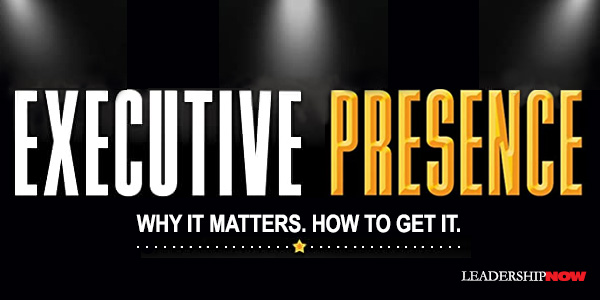 |
 |
11.22.22

Executive Presence: Why it Matters. How to Get it.
HOW IMPORTANT is executive presence? “No one can realize their full potential without executive presence,” says Joel Garfinkle. Seventy-eight percent of business leaders state that a low level of executive presence paralyzes career advancement. Executive presence is another way of saying leadership presence and should be a part of our personal leadership development agenda. “Practicing the skills that support a strong executive presence will lay the groundwork for becoming the best leader possible.” Executive Presence by Joel Garfinkle will show you the right qualities to be practicing and the specific behaviors that will highlight your strengths and increase your contribution as a leader. It is possible for the self-absorbed person to come across with the appearance of executive presence, but as Abraham Lincoln is often credited as saying, “You can fool all the people some of the time and some of the people all the time, but you cannot fool all the people all the time.” Garfinkle says: They can talk a good game and may even rise up through the ranks because some leaders perceive their arrogance as confidence. However, they lack essential qualities of executive presence that will make them truly a great leader, and most experienced leaders will see through them. Great leaders are committed to nurturing others, leveraging all of their executive presence qualities for the good of the team rather than just personal gain. And this is really what the endgame of executive presence is. Your confidence is people-centered. Executive presence is about lifting other people up, not dominating them. So, as you practice these behaviors, it is helpful to understand the why of building executive presence. Garfinkle has created the 3x3 Executive Presence Model—as shown below—to guide you in developing your executive presence. It sets up three domains, each containing three core competencies. “To cultivate executive presence, you need to look closely at how you show up at work, how you speak, and how you make decisions.”
What holds us back more than anything else is self-doubt. It is our internal beliefs that limit us. By examining the 3x3 Model, we can more easily see what internal thinking may be controlling the behaviors that hold us back from being as effective as we could be. The competencies that have been identified in the Model need to be in balance. “When a person has a great deal of one quality but not complementary ones, it can undermine their overall executive presence.” For instance, a leader who comes across as always in command but who hasn’t cultivated charisma probably won’t seem approachable. Such people tend to intimidate others and seem domineering, which negatively affects their ability to lead. Similarly, leaders who are extremely decisive but can’t vocalize the reason behind their decisions will have trouble gaining buy-in. To have executive presence, you need to develop the overall package, not just a few select characteristics. Many of us have some of these core competencies, but not all. The Model will help us to find the balance we need by filling in the gaps. What is particularly useful are the chapters discussing in depth the specific behaviors associated with each of the nine core competencies. There are questions, evaluations, and exercises throughout the book to guide you step-by-step and keep you on the right path. 
Posted by Michael McKinney at 08:01 AM
|
BUILD YOUR KNOWLEDGE
 

How to Do Your Start-Up Right STRAIGHT TALK FOR START-UPS 
Grow Your Leadership Skills NEW AND UPCOMING LEADERSHIP BOOKS 
Leadership Minute BITE-SIZE CONCEPTS YOU CAN CHEW ON 
Classic Leadership Books BOOKS TO READ BEFORE YOU LEAD |